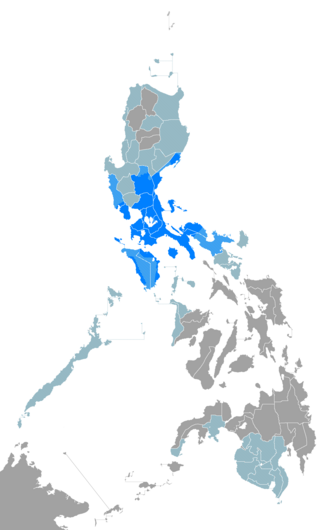
Tagalog is an Austronesian language spoken as a first language by the ethnic Tagalog people, who make up a quarter of the population of the Philippines, and as a second language by the majority. Its standardized form, officially named Filipino, is the national language of the Philippines, and is one of two official languages, alongside English.

Luzon is the largest and most populous island in the Philippines. Located in the northern portion of the Philippines archipelago, it is the economic and political center of the nation, being home to the country's capital city, Manila, as well as Quezon City, the country's most populous city. With a population of 64 million as of 2021, it contains 52.5% of the country's total population and is the fourth most populous island in the world. It is the 15th largest island in the world by land area.

Filipino is a language under the Austronesian language family. It is the national language of the Philippines, and one of the two official languages of the country, with English. It is a standardized variety of Tagalog based on the native dialect, spoken and written, in Metro Manila, the National Capital Region, and in other urban centers of the archipelago. The 1987 Constitution mandates that Filipino be further enriched and developed by the other languages of the Philippines. Filipino is only used as a tertiary language in the Philippine public sphere.

Southern Tagalog, designated as Region IV, was an administrative region in the Philippines that comprised the current regions of Calabarzon and Mimaropa, the province of Aurora of Central Luzon, and several cities of Metro Manila. The name remains as a cultural-geographical region only, which exempts Aurora.

Pangasinan (Pangasinense) is an Austronesian language, and one of the eight major languages of the Philippines. It is the primary and predominant language of the entire province of Pangasinan and northern Tarlac, on the northern part of Luzon's central plains geographic region, most of whom belong to the Pangasinan ethnic group. Pangasinan is also spoken in southwestern La Union, as well as in the municipalities of Benguet, Nueva Vizcaya, Nueva Ecija, and Zambales that border Pangasinan. A few Aeta groups and most Sambal in Central Luzon's northern part also understand and even speak Pangasinan as well.
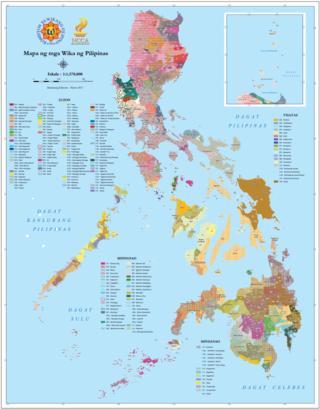
There are some 120 to 187 languages spoken in the Philippines, depending on the method of classification. Almost all are Malayo-Polynesian languages native to the archipelago. A number of Spanish-influenced creole varieties generally called Chavacano along with some local varieties of Chinese are also spoken in certain communities. The 1987 constitution designates Filipino, a standardized version of Tagalog, as the national language and an official language along with English. Filipino is regulated by Komisyon sa Wikang Filipino and serves as a lingua franca used by Filipinos of various ethnolinguistic backgrounds.
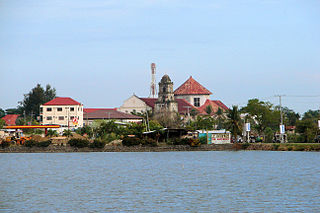
Binmaley, officially the Municipality of Binmaley, is a 1st class municipality in the province of Pangasinan, Philippines. According to the 2020 census, it has a population of 86,881 people.

Maguindanao, Maguindanaon or Magindanao is an Austronesian language spoken by a majority of the population of Maguindanao del Norte and Maguindanao del Sur in the Philippines. It is also spoken by sizable minorities in different parts of Mindanao such as the cities of Zamboanga, Davao, and General Santos, and the provinces of North Cotabato, Sultan Kudarat, South Cotabato, Sarangani, Zamboanga del Sur, Zamboanga Sibugay, as well as Metro Manila. This was the language of the historic Sultanate of Maguindanao (1520–1905), which existed before and during the Spanish colonial period from 1565 to 1898.
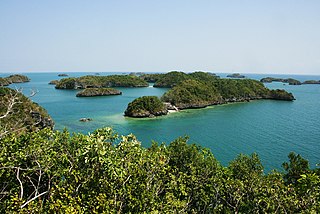
Pangasinan, officially the Province of Pangasinan, is a coastal province in the Philippines located in the Ilocos Region of Luzon. Its capital is Lingayen. Pangasinan is in the western area of Luzon along Lingayen Gulf and the South China Sea. It has a total land area of 5,451.01 square kilometres (2,104.65 sq mi). According to the 2020 census it has a population of 3,163,190. The official number of registered voters in Pangasinan is 1,651,814. The western portion of the province is part of the homeland of the Sambal people, while the central and eastern portions are the homeland of the Pangasinan people. Due to ethnic migration, the Ilocano people settled in the province.

Bautista, officially the Municipality of Bautista, is a 4th class municipality in the province of Pangasinan, Philippines. According to the 2020 census, it has a population of 35,398 people.

Binalonan, officially the Municipality of Binalonan, is a 1st class municipality in the province of Pangasinan, Philippines. According to the 2020 census, it has a population of 56,382 people.

Calasiao, officially the Municipality of Calasiao, is a 1st class municipality in the province of Pangasinan, Philippines. According to the 2020 census, it has a population of 100,471 people.

San Jacinto, officially the Municipality of San Jacinto, is a 3rd class municipality in the province of Pangasinan, Philippines. According to the 2020 census, it has a population of 44,351 people.
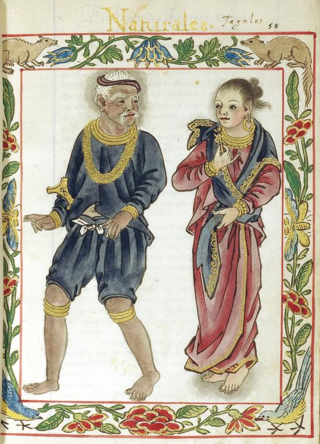
The Tagalog people are the largest ethnolinguistic group in the Philippines, numbering at around 30 million. An Austronesian people, the Tagalog have a well developed society due to their cultural heartland, Manila, being the capital city of the Philippines. They are native to the Metro Manila and Calabarzon regions of southern Luzon, and comprise the majority in the provinces of Bulacan, Bataan, Nueva Ecija and Aurora in Central Luzon and in the islands of Marinduque and Mindoro in Mimaropa.
The Pangasinan people, also known as Pangasinense, are an ethnolinguistic group native to the Philippines. Numbering 1,823,865 in 2010, they are the tenth largest ethnolinguistic group in the country. They live mainly in their native province of Pangasinan and the adjacent provinces of La Union and Tarlac, as well as Benguet, Nueva Ecija, Zambales, and Nueva Vizcaya. Smaller groups are found elsewhere in the Philippines and worldwide in the Filipino diaspora.

The following outline is provided as an overview of and topical guide to the Philippines:
Gregorio "Greg" C. Laconsay is a Filipino-Ilocano editor and writer in the Philippines. He was the former editor in chief for two prominent literary magazines in the Philippines, namely the Ilocano-language Bannawag and the Tagalog-language Liwayway.

In early Philippine history, barangay is the term historically used by scholars to describe the complex sociopolitical units which were the dominant organizational pattern among the various peoples of the Philippine archipelago in the period immediately before the arrival of European colonizers.

JAC Liner Inc. is one of the largest bus companies in the Philippines serving the riding public en route to Southern Luzon provinces which includes key destinations in the provinces of Laguna, Batangas, Quezon and Marinduque.
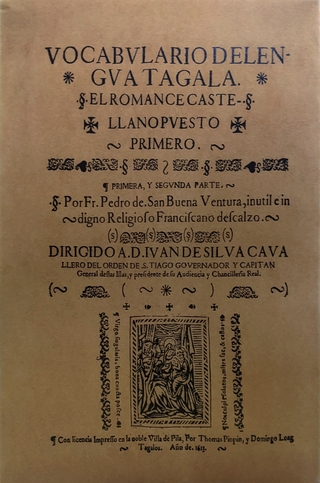
Vocabulario de la lengua tagala was the first dictionary of the Tagalog language in the Philippines, It was written by the Franciscan friar Pedro de San Buena Ventura and published in Pila, Laguna in 1613. Juan de Plasencia had written a vocabulario earlier but it was not printed. More than a century later, a dictionary of the same name was prepared by Jesuit priests Juan de Noceda and Pedro de Sanlucar; their first edition was published in Manila in 1754 and then the second in 1860 which was reissued by the Komisyon sa Wikang Filipino in 2013.

















